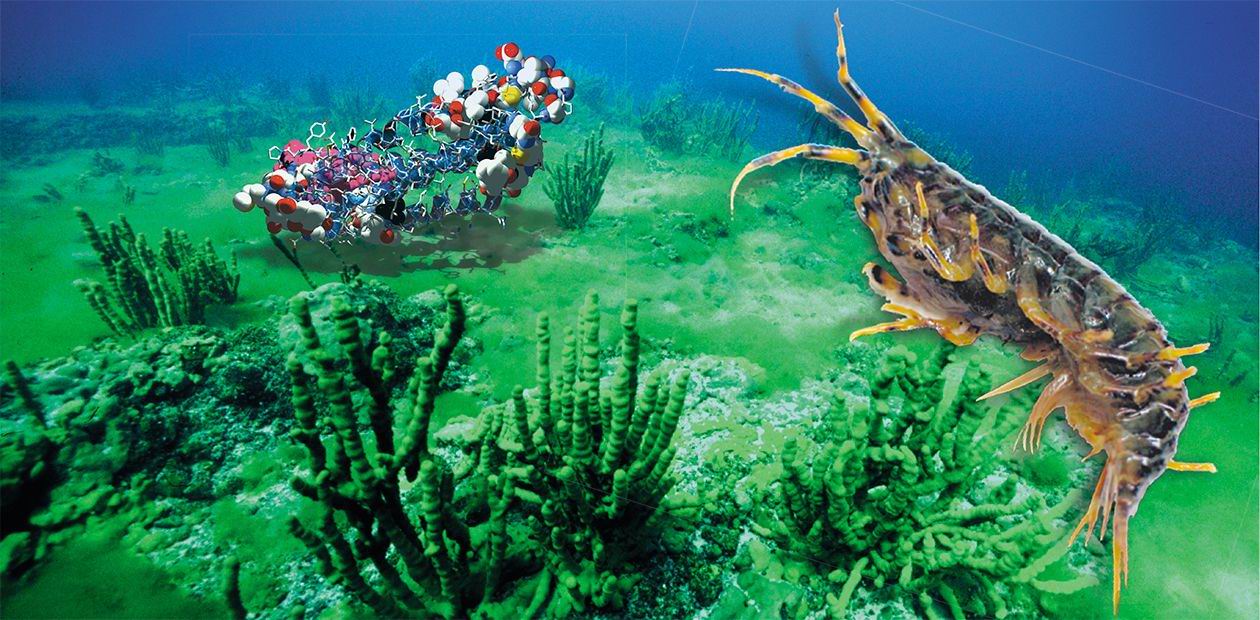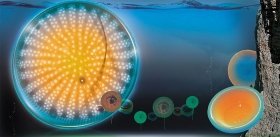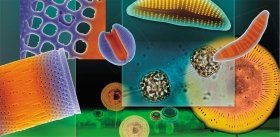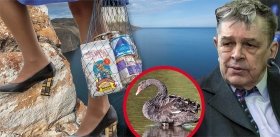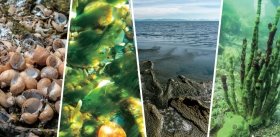Nucleotide Chronicles of Troubled Time
Scientists, at least biologists, could be conventionally divided into two categories. Those who belong to the first category (since childhood they have been called ‘grinds’) devote their lives to describing the object of their love, the subject of their scientific research. Being passionate collectors, they consider the world as a huge ‘museum,’ in which unfortunately not all ‘exhibits’ are provided with detailed labels. The other category, let us call them inquisitive natures, throughout the life keeps unselfish interest in natural phenomena and their mechanisms. They wish to get at the heart of the matter and do not care if the research object is a huge whale or an unremarkable Drosophila, since the real work begins with a transparent droplet of DNA solution…
While speaking about Lake Baikal, people often use superlative forms of adjectives. The lake is the oldest and the deepest. As to the number of animal species, they are literally countless because no one knows the exact number. If tomorrow it is announced that the number is greater by two thousand, the scientific community will hardly be surprised.
What major problems concerning the lake are of particular interest? Today it is the question of how and why this amazing diversity of species appeared and evolved. To understand this, one should reconstruct the sequence of events, determine who is who and who originated from whom. Revealing the mechanisms, which resulted in such a striking diversity in the relatively closed ecosystem, is important not only for getting an insight into the lake itself, but also for the evolutionary theory in general.
Unfortunately, when we deal with a flock of tens to hundreds closely related species, it is extremely difficult to establish their evolutionary relations on the basis of morphological criteria (antennas, aciculae, etc.) accepted in systematics, since the groups have many parallel features. Using this approach, it is next to impossible to estimate the divergence time of these groups in the remote past, especially if the organisms have not left any fossil records because of their ‘spinelessness’. If we are unable to relate the speciation processes to the changes of the ecosystem proper, we are unable to reveal the evolutionary mechanisms.
Revealing the mechanisms, which resulted in such a striking diversity in the relatively closed ecosystem, is important for the evolutionary theory in generalFortunately, during the last century genetics and molecular biology gave birth to a new scientific discipline, molecular systematics, which provides an unbiased and often unique way to study evolutionary relationships between the organisms, to compare not only their appearance, but also the heredity, the degree of genetic proximity.
The Promised Land
Baikal has always been Mecca for zoologists and taxonomists. During the last century natural scientists came here to study the anatomy of various animals caught here. To discover a new species, it sufficed to catch about a dozen of creatures that looked alike and had not been described before! It became clear soon that many species in Baikal, especially those belonging to species flocks, are extremely variable: if there is a continuity of intermediate forms between the species A and species B, one can hardly find the border between them. Baikal is characterized by fantastic intraspecific morphological diversity, thus only an experienced zoologist can distinguish, for example, the species of gammarus by external features after a painstaking examination with the help of a microscope. This might make people think about revising the concept of ‘species’.
Taxonomists faced the challenge when the ancient African lakes, Baikal’s congeners, were investigated. The studies of cichlid fishes proved that the individuals differing in morphology and behavior could have very similar genomes and could easily interbreed under changing environmental conditions. This suggests that the classical genetic definition of ‘species’, which means genetic isolation (otherwise, reproductive isolation), does not work in this case. The disputes on this subject were fueled by further advances in molecular biology, in particular, when an opposite tendency was found (very large genetic distances at similar appearance and habitat conditions).
As a result, even some fundamental aspects were questioned, as, for example, the relativity of species: before that both geneticists and morphologists defined species as something distinct from other species. The efforts to define ‘biological species’ yielded ‘coalescent’ definitions considering ‘a species’ as a group of individuals whose uniformity is maintained by special mechanisms.
Not By A Net Alone …
How are genes compared? The principle of comparative analysis of DNA is simple. It suggests that the same functions are fulfilled, as a rule, by homologous, i. e., similar, proteins. For example, hemoglobins, blood proteins, are in everybody, in humans, animals, birds, fish, and insects. Using the proteins, scientists can usually trace the descent of all similar organisms to a certain common ancestor. Thus, the more distinct our hemoglobins are, the more ancient our common ancestor is.
If we recall the lessons of general biology, we can see how all this is associated with DNA. The structure of any protein is inscribed in a certain segment of chromosomal DNA, called ‘gene’. Each protein amino acid is coded by a triplet of nucleotides, ‘elementary units’ of DNA. Using molecular methods, we can ‘read’ certain gene fragments, compare their nucleotide sequences, count the replacements, and then estimate probable relation degree. Certainly, it is easier said than done, however, it is quite feasible.
The phylogenetic approach to molecular evolution allows us to estimate the time of major evolutionary events and to approach the understanding of the reasons for the extraordinary biodiversity of all great ancient lakesLet us consider the ‘molecular clock’ hypothesis. If we admit that the frequency of gene mutations is constant for a long time, from the number of amino acid replacements in a protein molecule or the number of the appropriate nucleotide replacements in a gene we can determine the approximate time when the common ancestor lived.
The phylogenetic approach to molecular evolution allows us to estimate the time of major evolutionary events and to approach the understanding of the reasons for the extraordinary biodiversity of all great ancient lakes. Though to do this, in addition to a net, a scalpel, and a magnifier used by a typical taxonomist, a molecular scientist should have a well equipped laboratory and be good at mathematics.
The Subject Of Inquiry
Thus, we have the problem, the fabulous biodiversity, molecular genetic methods to tackle it, and the appropriate subject of inquiry, Baikal organisms, including the invertebrates. These are amphipods, mollusks and oligochaeta, close relatives of earthworms, which have different ecological characteristics, are abundant and widely spread. Amphipods are free-living organisms that are found throughout the water mass, the other two species live near the bottom.
The ancestors of these groups lived in ancient Baikal, which stayed at the same place for approximately 30 million years, but changed a lot over time. Cooling and warming periods alternated. The water level varied. Glaciers descended. Tectonic movements and other geological processes occurred. It is quite possible that the Baikal waters were not always fully oxygenated, as they are now. At those times it is likely that oxygen was available only in the upper 200 m, as in the Black Sea or Lake Tanganyika now.
These were the conditions faced in the antiquity by the ancestors of the animals that we are studying today. The question on the ways of populating of Baikal caused heated discussions among classical biologists: some believe that Baikal was occupied by relic Mesozoic fauna, while the others think that settling should have occurred later because at those times the lake was bound by ice. Molecular biology allowed us to consider this question from a principally new viewpoint.
Born To Crawl Will Loose The Race
How did it start? Molecular phylogenetics is not an easy thing, it was the more so in the early 1990s. Molecular-phylogenetic studies were started at the Limnological Institute under the supervision of S. J. Slobodyanyuk, who is now at the Novosibirsk Institute of Cytology and Genetics. The object of the studies was Cottoidei fish, Baikal sculpin. We continued these studies but focused them on benthic invertebrates.
At that time few scientists could do the studies, because the methods of mass DNA sequencing had just appeared, as well as the polymerase chain reaction that allowed unlimited replication of DNA segments. We had gone through some tough moments before we selected the appropriate ‘model’ genes for each group of organisms.
Thus, we determined that the common ancestor of modern mollusks of the family Baicaliidae lived in Baikal not later than 3.5 million years ago. Then the speciation burst resulted in the splitting of the genealogical tree of the family into two main trunks.
Owing to the fact that strong shell of these crumbs withstood the time, paleontologists could find eight species of this family in the sediments whose age is more than 20 million years! Their results were in conflict with our data. One could guess that the paleontologists were deceived with the similarity of shells and had no chance to check other features because soft tissues of mollusks were not preserved in the sediments. But could both parties be right? The contradicting data can be reconciled if we suggest that upon mass extinction few survivor lineages engendered new species.
The organisms, which move slowly on the bottom and never come off it, are relatively ‘young’ as compared to the age of BaikalThe species tree of Oligochaeta (family Lumbriculidae) is divided into several ancestral branches that are very ancient and remote from each other. The time of their divergence is estimated as 28—30 million years ago. But the youngest branch that formed the magnificent bouquet of species of Lamprodrilus group gemmated ‘only’ 3.8—2.8 million years ago. Three million is the magical number, the same as for Baicaliidae!
Nothing special happened to amphipods at that time. The most part of modern species of amphipods probably originated from the few ancestor forms that existed at least 28—30 million years ago. This date corresponds to the true age of the lake, the time when it formed as a rather deep-water continuously existing reservoir. Our colleagues dealing with other groups of Baikal organisms obtained analogous results. Summing up, the organisms, which move slowly on the bottom and never come off it, are relatively ‘young’ as compared to the age of Baikal. One can suggest that about 3—4 million years ago the lake was frequently subject to catastrophic phenomena. Crawling species were more endangered by the environment disasters than free-floating amphipods. Thus, the bottom inhabitants disappeared leaving few separate ‘islets’ that gave rise to new groups and species.
The Model Show
Now that we have got a general overview we should examine it closely because the charm of each story is in details. The purely molecular approach provides only an outline, the facts. To put it more exactly, it yields the sequence of evolutionary events, which, as the evidence of crime, should be interpreted using one’s wit and transformed into convincing proofs.
Fortunately, by the end of the 1990s powerful computers were designed. Bioinformatics and mathematical biology developed in parallel with molecular biology. Bioinformation scientists identify and compare genes in the genomes of different organisms, mathematical biologists construct models. However, classical biologists have some difficulties in applying the results obtained by these disciplines to their work. Molecular taxonomists, for example, see the world through the ‘wood’ of evolutionary trees. It is not easy to superimpose the image of the world and mathematical curves tracing the time and space changes of completely immeasurable values such as ‘generalized individual adaptive fitness’. We tried to form an original biological-mathematical alliance that would integrate these areas of knowledge using mathematics as a tool for understanding, as it was originally designed.
The same events can be described using systems of differential equations or sets of specific ‘destinies’We preferred to use the so-called ‘individual-oriented simulation’, which makes it possible to describe certain events using systems of differential equations customary for mathematicians and sets of specific destinies. This is like a computer game, in which different animals ‘live their own life’: compete with one another, feed or die of hunger, reproduce, and pass the genes onto their posterity. Genes are inherited from one generation to the next, pass through many generations, cross occasionally, and mutate.
Let us illustrate the idea by the example of our Lumbriculidae and Baicaliidae, the organisms living at the depth of 20 meters in a 15-m wide band, i. e., the narrow closed tape that engirds the lake. Their life is movement in the circle: they are born, then they creep, eat, share genes, if they are lucky enough to find something to eat and not to be eaten. To reach our goal, we add an option of neutral evolution of genes, i.e., built-in molecular clocks.
Our model can make forecasts: setting the data, we can choose the most probable scenario of the events that happened in the remote pastFirst, the software had to be designed to transform the results of the models into the form identical to that of experimental data obtained by molecular biologists and ecologists. Further, using the information about real transformations occurring in our ecosystem, we simulated the circumstances that could lead to the current situation. Now our model can make forecasts: setting the data, we can choose the most probable scenario of the events that happened in the remote past. In addition, computer simulations allow one to plan the efforts and estimate the costs, which is important for arranging the studies in molecular systematics, where the routine is far from being cheap.
What Species Do You Belong To?
Our models can provide answers to some very interesting questions about speciation processes. Generally speaking, it is hard to understand what is speciation, because from the point of view of the current generation this phenomenon does not exist at all. Who knows, may be a new species of humans has been already formed, Homo but something else rather than sapiens. It could already be isolated, but nobody notices this. Potentially, each of us could be a new species. But this can be detected only in an enormous number of generations. It is believed that the process takes from two to a hundred thousand years depending on the specific speciation mechanism.
Who knows, may be a new species of humans has been already formed, Homo but something else rather than sapiens. Potentially, each of us could be a new speciesSimulation of the processes of ‘explosive’ speciation observed on Baikal is a rather complicated problem. To estimate the adequacy of such a model to real events, one should use various data, for example, those about the ancient African lakes, which are similar to Baikal even in the geographical parameters and should have been influenced by the global climate changes simultaneously with Baikal but in a different way.
Playing with models is a fascinating occupation. Some simple models can explain such surprising things as, for example, the phenomenon of parthenogenesis, when a species refuses syngenesis. There is also the most interesting problem: coevolution (joint evolution) of a predator and a victim, when the species have a kind of ‘arms race’. There are plenty of other insufficiently studied or unstudied problems at the most ancient and deepest lake, in which God’s creatures are uncountable.


